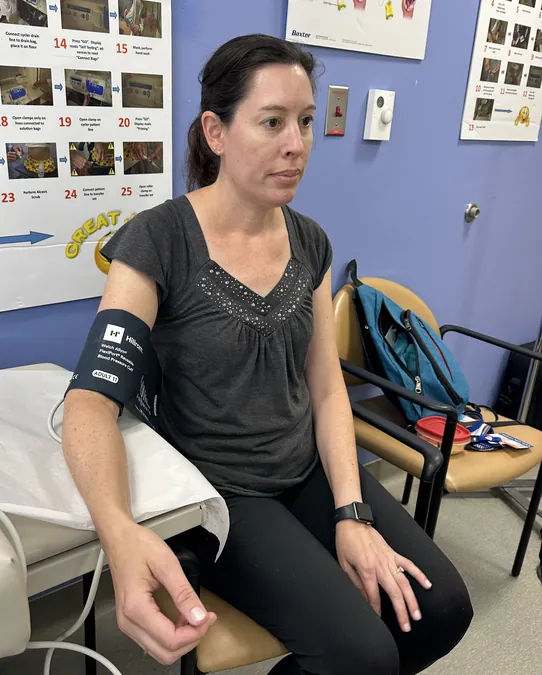
Study Reveals Shocking Truth About Blood Pressure Measurements: Are Clinics Getting It Wrong?
2024-10-07
Author: Mei
Groundbreaking Research from Johns Hopkins Medicine
A groundbreaking study from Johns Hopkins Medicine has unveiled that the common practices used during blood pressure (BP) screenings may be seriously flawed, leading to a considerable overestimation of blood pressure readings that could ultimately result in misdiagnosed hypertension.
Impact of Arm Position on BP Measurements
Published in JAMA Internal Medicine on October 7, 2023, the research explored how three different arm positions—supported on a desk, resting on a lap, and hanging unsupported at the patient's side—impact BP measurements.
Startling Results
The results are startling. The study found that positioning the arm on the lap inflated systolic pressure (the top number in a reading) by nearly 4 mmHg, while an unsupported arm hanging at the side skewed the readings upward by approximately 7 mmHg. Such discrepancies could mean the difference between a normal and an elevated blood pressure diagnosis.
Expert Insights
Tammy Brady, M.D., a prominent researcher involved with this study, stressed the critical importance of proper arm support during BP measurements, asserting that a simple adjustment can make a 'huge difference' in achieving accurate results. These findings shine a light on the necessity for healthcare providers to adhere to clinical guidelines that advocate for firm support of the arm, preferably on a desk or table, during BP evaluations.
The Importance of Accurate Measurements
According to the American Heart Association, almost half of adults in the U.S. grapple with elevated blood pressure—classified as having a force of blood flow that surpasses the average norm of 120/80 mmHg. If left untreated, high blood pressure significantly increases the risk of severe health issues, including strokes and heart attacks. This silent killer often manifests with little to no symptoms, underlining the importance of routine screenings as a fundamental aspect of hypertension management.
Control Measures and Lifestyle Adjustments
Lifestyle interventions, such as weight management, healthy eating, and regular exercise, along with medication when necessary, are typically effective in controlling blood pressure. However, accurate measurements are vital for appropriate diagnosis and treatment.
American Heart Association Guidelines
The American Heart Association's current guidelines highlight several steps for achieving precise BP readings. These include appropriate cuff size, ensuring the patient’s back is supported, feet flat on the floor without crossed legs, and importantly, correct arm positioning at heart level—favoring a sturdy surface to support the arm.
Common Pitfalls in BP Assessments
Despite these established recommendations, patients often find themselves with inadequate arm support during BP assessments, sitting on an examination table, or having their arm held by clinicians. The researchers conducted their study with 133 adult participants, representing a diverse demographic, to thoroughly investigate this issue.
Controlled Measurement Study
Each participant engaged in a set of carefully controlled measurements using a digital BP device, following an established protocol to mimic typical clinical scenarios. The results unequivocally indicated that commonly utilized arm positions misrepresented blood pressure readings significantly compared to the recommended arm-on-the-desk position.
Impact on Clinical Decisions
The shocking numbers reveal that measuring BP with an unsupported arm can inflate systolic measurements by as much as 6.5 mmHg, which could drastically alter clinical decisions—potentially shifting a patient's status from normal to stage 2 hypertension, which is characterized by readings ranging from 130 to 140 mmHg.
Technological Considerations
The researchers were careful to note that their findings pertain primarily to screenings conducted with automated BP devices, suggesting that results may vary depending on the equipment used.
Conclusions and Recommendations
Overall, this study serves as a powerful reminder of the importance of adhering to best practice guidelines in clinical settings. As Dr. Brady pointed out, not only should healthcare professionals be vigilant in following these protocols, but patients must also take an active role in advocating for accurate blood pressure measurements both in clinical environments and at home.
Call to Action for Patients
Is your BP being measured correctly? It may be time to ask your provider if your arm is really supported!





 Brasil (PT)
Brasil (PT)
 Canada (EN)
Canada (EN)
 Chile (ES)
Chile (ES)
 España (ES)
España (ES)
 France (FR)
France (FR)
 Hong Kong (EN)
Hong Kong (EN)
 Italia (IT)
Italia (IT)
 日本 (JA)
日本 (JA)
 Magyarország (HU)
Magyarország (HU)
 Norge (NO)
Norge (NO)
 Polska (PL)
Polska (PL)
 Schweiz (DE)
Schweiz (DE)
 Singapore (EN)
Singapore (EN)
 Sverige (SV)
Sverige (SV)
 Suomi (FI)
Suomi (FI)
 Türkiye (TR)
Türkiye (TR)